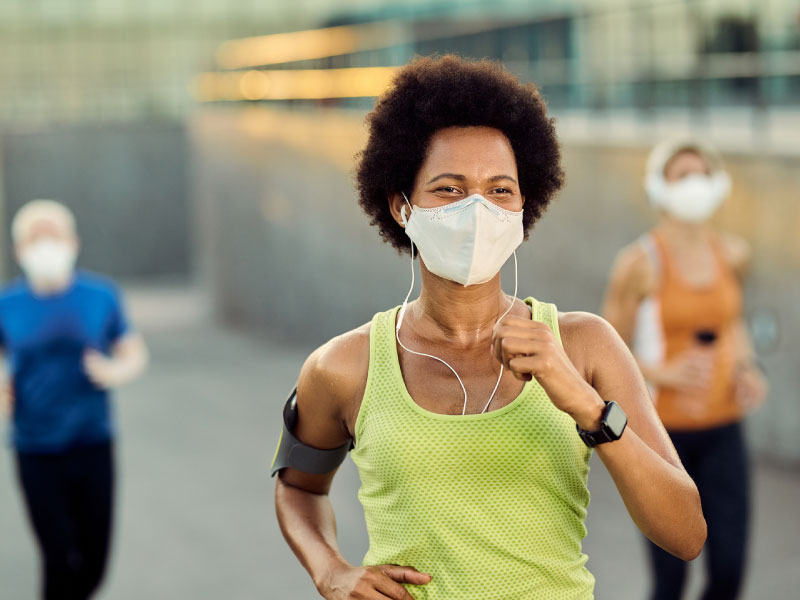Creative ways to exercise during the pandemic
By the American Heart Association

With the coronavirus causing some gym-goers and regulars at the local recreation center to reconsider their workout spot, staying physically active means getting creative with an exercise routine closer to home. There are lots of safe ways to work out while maintaining physical distance.
Early fall is a prime time to go outdoors to walk, run or bicycle, said Russell Pate, a professor in the University of South Carolina's department of exercise science. Coronavirus transmission risk appears to be reduced outdoors, he noted, adding, "We're constantly learning about this virus."
The Centers for Disease Control and Prevention recommendations for preventing COVID-19 spread call for maintaining a six-foot distance from others in public; frequent hand-washing, for at least 20 seconds; and using a cloth face cover over your nose and mouth when around others. The face cover is not a substitute for physical distancing.
Tennis and golf are good ways to stay active with the right precautions. For example, many golf courses are requiring face coverings, closing ball-washing stations and setting up greens so that players don't have to touch the flag.
Swimming can be safe if physical distancing is maintained at an outdoor pool or other body of water. The risk of transmitting the coronavirus through water appears to be minimal, Pate said.
If a nearby state or national park is open, consider taking a hike, said Teresa Kay-Aba Kennedy, a holistic health counselor and CEO of Power Living Enterprises, Inc. Not only is it a way to exercise, but enjoying nature and fresh air can provide a fresh perspective.
She suggests hiking with a family member or a friend, if possible, who will stay six feet away. Take along hand sanitizer and remember public restrooms may be closed.
Get creative with movement
Many people are using this time as an opportunity to exercise more, and they are exploring new ways to do it. Online classes and workout groups are growing in number and popularity. Other e-tools include fitness apps and YouTube videos that encourage aerobic activity, strength training, yoga and Pilates.
"One fun thing to do indoors is have a virtual Zoom dance party with friends at a certain time every week or even every day," Kennedy said. "With the built-in social connection and a set schedule, you will be more likely to commit to it."
Having a schedule for exercise, work time and meals helps in regaining a sense of control after disruption in our normal lives, she said.
Gardening, vacuuming or cleaning out the garage are other ways to stay active at home. Your body gets the health benefits of movement, even if it's by doing a household chore, Pate said.
Immediate and long-term health benefits
Long-term health benefits of physical activity include reducing the risk of cardiovascular disease, Type 2 diabetes and weight gain.
Sometimes overlooked, Pate said, are the more immediate positive effects of exercise: reduced anxiety, reduced risk of depression and less sedentary time. Exercise also promotes social connections, even with physical distancing or online workout partners.
Exercise is a "stress buster," Kennedy said, and can instill a positive mindset if you find yourself consumed with bad news.
Keep the kids moving, too
One advantage of this stay-at-home period is it allows time to get the whole family involved in physical activity, said Pate, director of the Children's Physical Activity Research Group at his university. Parents can encourage children to step away from video games and get moving by exercising with them and making sure to have outdoor games and equipment on hand.
"That means balls and hoops and badminton nets and all of the things that support physical activity," he said. "Kids are much more likely to be physically active if they're outside than inside."
The American Heart Association guidelines recommend adults get at least 150 minutes per week of moderate-intensity aerobic activity or 75 minutes per week of vigorous activity, or a combination of both, preferably spread throughout the week. Children ages 6 to 17 should get at least 60 minutes per day of moderate- to vigorous-intensity physical activity, while children under age 5 should be physically active and have plenty of opportunities to move each day.6
Whatever the exercise setting, always be aware of those around you and make a safe decision for yourself and others, Pate said. "We've got to be smart about it right now."
This article was developed by the American Heart Association with financial support from Transamerica.
If you have questions or comments about this story, please email [email protected].





